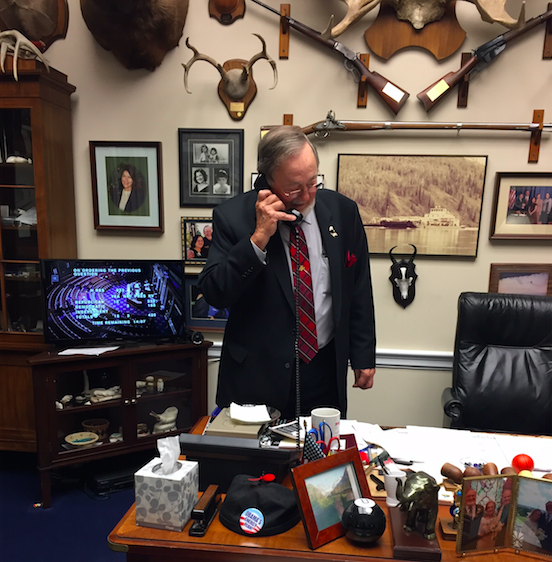WHO WON THE MOST VOTES IN THE STATEWIDE RACES?
During the August Primary Election, 111,473 ballots were cast in Alaska. Which candidates in the statewide races pulled in the most?
Top Republican vote winners statewide:
1. Don Young, incumbent U.S. House: With 47,948 votes, the Dean of the House wins the prize. Again.
2. Mike Dunleavy, Republican candidate for governor: 42,233
3. Kevin Meyer, Republican candidate for lt. governor: 23,074
4. Mead Treadwell, Republican candidate for governor 22,078
5. Edie Grunwald, Republican candidate for lt. governor: 17,478
6. Thomas Nelson, Republican candidate for U.S. House: 10,512
The difference between Young’s count for U.S. House and Dunleavy’s count for governor was 5,715 votes, but Young had no strong Republican opponent, while Dunleavy faced Mead Treadwell.
But how is it that Sen. Kevin Meyer, running for lieutenant governor in a crowded field of six Republican candidates, was able to muster nearly 1,000 more votes than gubernatorial candidate Treadwell, who is both the former lieutenant governor and former U.S. Senate candidate with big name recognition?
Possibly because Treadwell jumped in the race for governor so late, which meant he never had time to make his case to voters.
Treadwell only did better than Dunleavy in three Alaska districts: In District 20, he won 41 more votes than Dunleavy; in District 32, he won 80 more votes; and in District 35, Treadwell won 98 more than Dunleavy.
Dunleavy swept every other district on the Republican side, including District 33, downtown Juneau, with Dunleavy winning 596 to Treadwell’s 515. (To be clear, on the Democrat ballot, Begich won 1,982 votes because District 33 is Begich country).
Dunleavy also won 92 percent of the precincts in Anchorage.
Top Democrat vote winners:
1. Debra Call, Democrat candidate for lt. governor: 32,880; in 2014, Hollis French was the top Democrat vote getter for lieutenant governor with 40,271.
2. Mark Begich, Democrat candidate for governor: 32,069; in 2014, Byron Mallott won 42,327 in the Democratic primary.
3. Alyse Galvin, Democrat candidate for U.S. House: 20,961, less than half of Rep. Don Young’s votes.
Wait, what? How did Debra Call get more votes than Begich on the Democrat ballot?
A possible explanation is the Libertarians had no person in the lieutenant governor’s slot, so likely those Libertarian voters simply put Debra Call in as their choice, since there was no one else on the ballot. Libertarians vote on the same ballot as the Democrats — the open ballot.
WHICH COMMUNITY HAD THE HIGHEST TURNOUT?
The precinct in Alaska with the highest turnout was Nikolai in District 37.
With a population of 94, and 73 people registered to vote, 39 votes were cast in Nikolai, for a stunning primary turnout of 53 percent.
Also doing well for turnout was Hughes, in District 40. Hughes has a population of 77. All but four of them — 73 people — are registered to vote, and 32 ballots cast for a turnout of 44 percent.
Following Hughes was Diomede, in District 39. The turnout there was 42 percent, with 32 of the 62 registered voters casting a ballot. Diomede’s population is 118.
WHICH COMMUNITY HAD THE LOWEST TURNOUT?
At this point, it’s Stevens Village, the one precinct in Alaska that has not reported its results to the Division of Elections. No one knows if Stevens Village even conducted an election at this point. There are 76 potential votes in Stevens Village, but no sign of them, and the village phones are not being answered.
The second lowest precincts for participation was a tie between Eielson Air Force Base in District 6, and JBER #2 in District 15, which both had a 1 percent turnout.
JBER is one of five precincts in District 15, where now a controversy over fraudulent voting has led to the Division of Elections turning over ballots to the Department of Law for investigation.
[Read: Criminal investigation underway, LeDoux up by 87 votes]

It’s interesting that the military bases don’t vote in primaries. Seems like some outreach is in order.
Bases are notoriously difficult to organize. Federal law and regulations prevent much of what is typically done for electioneering. Plus the residents don’t have the type of community attachment that is found elsewhere. Presidential elections are a totally different story.
How does Hughes have a population of 77 and 73 registered voters? Are there no children in Hughes? Or only four? Something is strange…